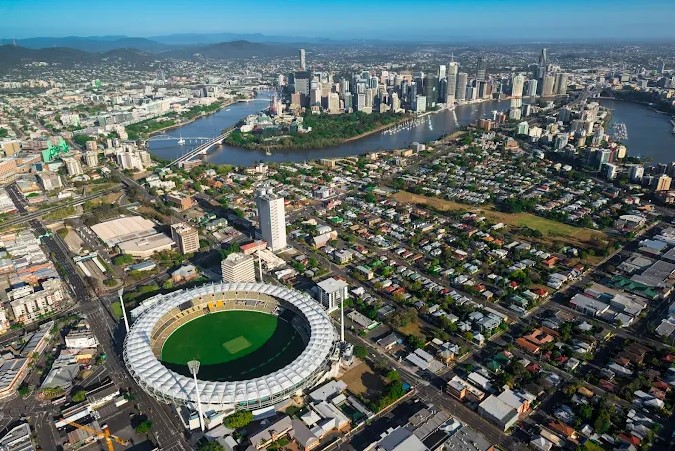The Gabba, formally known as the Brisbane Cricket Ground, is one of Australia’s most iconic sporting venues. Located in the suburb of Woolloongabba in Brisbane, this stadium has been a staple of the Australian sporting scene for well over a century. Hosting cricket in the summer and AFL in the winter, the Gabba is not just known for its raucous crowds and memorable matches, but also for its unique dimensions—especially its boundary lengths.
Table of Contents
While boundary lengths might seem like a dry technicality, they significantly influence how sports are played and how athletes prepare. Let’s unpack what makes The Gabba unique in this regard.
What Is a Stadium Boundary Length?
In cricket, the “boundary length” refers to the distance from the center of the pitch to the edge of the playing area. It is where a ball must reach to be counted as a four (if it bounces) or six (if it goes over the fence on the full). In AFL, field size plays a different role, but length and width still affect game strategy, positioning, and even player fatigue.
Unlike some stadiums where the field shape is symmetrical, the Gabba has a slightly oval shape, and its boundary lengths vary depending on direction.
Field Layout and Dimensions
Here is a breakdown of the Gabba’s cricket field dimensions:
| Measurement | Length (meters) | Notes |
|---|---|---|
| East-West (long axis) | ~170 meters | The longest axis of the oval |
| North-South (short axis) | ~150 meters | Shorter, across the square |
| Straight Boundary (from pitch) | 85–94 meters | Varies slightly based on match setup |
| Square Boundary | 72–78 meters | Generally shorter than the straight boundary |
| Behind-the-wicket | ~74–76 meters | Commonly used for paddle and scoop shots |
These figures are averages, as the exact position of the pitch can shift slightly depending on the match format (Test, ODI, or T20).
Comparison with Other Grounds
The Gabba’s boundary lengths are among the longest in Australia, especially in Tests. Here’s how it stacks up against other major Aussie stadiums:
| Stadium | Average Straight Boundary (m) | Square Boundary (m) |
|---|---|---|
| MCG (Melbourne) | 85–90 | 86–91 |
| SCG (Sydney) | 75–80 | 65–68 |
| Optus Stadium | 83–87 | 78–82 |
| Adelaide Oval | 81–87 | 70–75 |
| Gabba | 85–94 | 72–78 |
Strategic Implications in Cricket
For Batsmen:
Longer boundaries, especially straight down the ground, mean that batsmen must time the ball better to clear the ropes. Lofted drives and long-range sixes require raw power. On the other hand, the slightly shorter square and leg-side boundaries can be more easily targeted with horizontal bat shots like pulls, sweeps, and cuts.
For Bowlers:
The extended straight boundary is a bowler’s ally. Especially for fast bowlers and spinners who love tossing the ball up, it gives a margin for error. Bowlers can bowl fuller lengths without as much risk of conceding sixes.
Fielding Tactics:
Captains often set deeper fielders on the longer boundaries, encouraging batters to hit toward longer parts of the ground where catching chances are higher.
The AFL Context: Bigger Field, More Ground to Cover
The Gabba also serves as the home ground for the Brisbane Lions in the Australian Football League (AFL). For AFL, the playing surface requirements are different but no less demanding. Here’s how it measures up:
| Measurement | AFL Standard Range | Gabba |
|---|---|---|
| Field Length | 135–185 meters | ~165 meters |
| Field Width | 110–155 meters | ~135 meters |
| Goal-to-goal arc | ~50 meters | ~50 meters |
The Gabba falls well within AFL’s regulatory dimensions, making it an ideal oval for high-speed, end-to-end football. The larger dimensions compared to rectangular stadiums provide space for open play, dynamic transitions, and wide kicking angles.
Impact on AFL Game Style
At the Gabba, the slightly narrower width compared to the MCG leads to quicker transitions and often more congested midfield battles. Teams like the Brisbane Lions, who are familiar with the layout, have used this to their advantage by structuring quicker and more direct ball movement strategies.
Design and Renovation Plans
The Gabba is set to be the centerpiece stadium for the 2032 Olympic Games in Brisbane. As part of these plans, the stadium will undergo a complete redevelopment. While architectural and logistical plans are still being finalized, there’s speculation that the field dimensions will remain consistent, given their suitability for both cricket and AFL.
Any alteration to field size, particularly boundary lengths, would have significant implications:
- Cricket: Could favor either batsmen or bowlers depending on the adjustments.
- AFL: Changes to width or length could require a rethink of tactics and team structure.
Boundary Science: Why Size Matters
The debate between large and small boundaries is ongoing in global cricket. Fans love high scores and sixes, but purists argue that longer boundaries showcase better skill.
The Gabba offers a rare balance:
- Encourages risk for reward.
- Maintains the traditional challenge for bowlers.
- Keeps matches competitive without being overly batter-friendly.
The boundary lengths at The Gabba are more than just measurements on a tape—they’re central to the character of every game played there. From cricket centuries to thrilling AFL goals, the size of the playing surface dictates the style, pace, and even the outcomes of matches.
Whether you’re a fast bowler trying to induce a false stroke, a batsman aiming for a towering six, or a midfielder chasing down a loose ball, the dimensions of The Gabba challenge every athlete to bring their best. As the stadium evolves into a future Olympic venue, one thing remains clear: its boundary lengths are a defining part of its sporting legacy.

